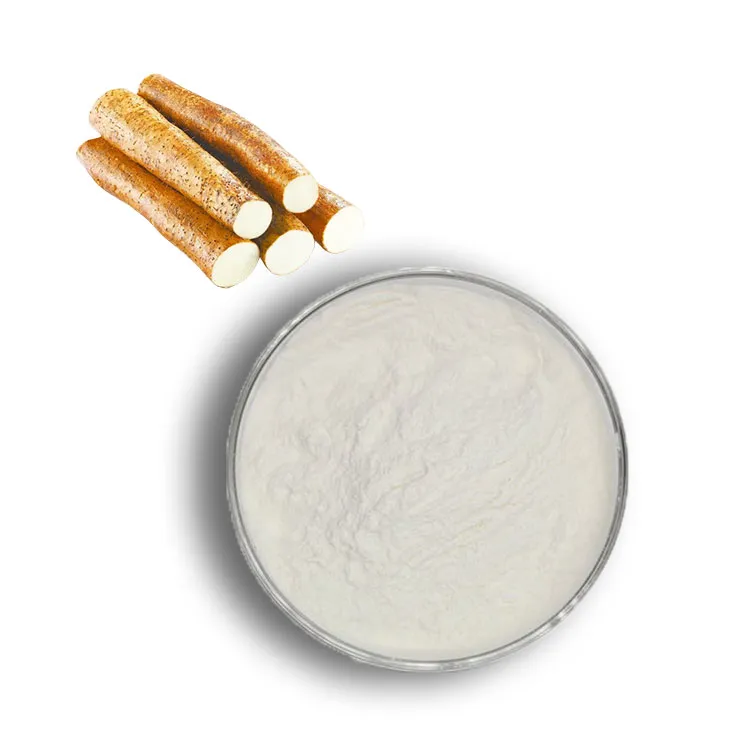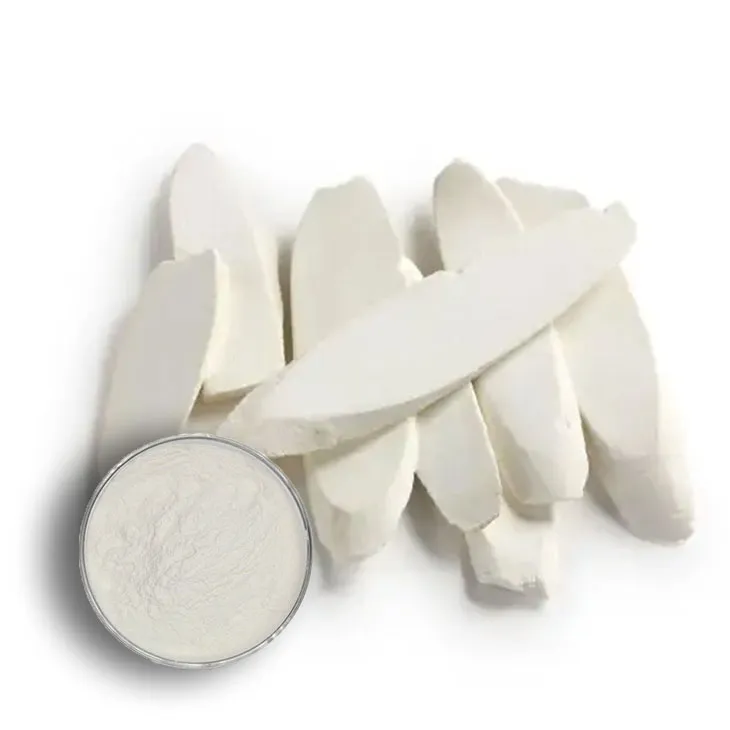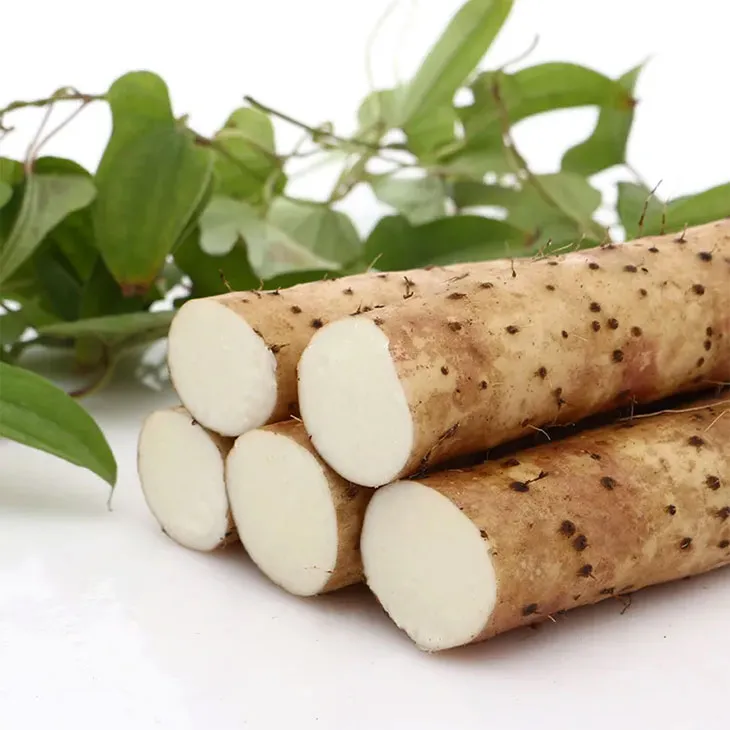- 0086-571-85302990
- sales@greenskybio.com
How to make powder from yam extract?
2024-11-30

1. Introduction to Yam Extract
Yam Extract is a valuable substance that has been increasingly recognized for its various beneficial properties. Yams are tuberous root vegetables that are rich in nutrients such as complex carbohydrates, dietary fiber, vitamins (like vitamin C, vitamin B6), and minerals (including potassium and manganese).
Significance in Health and Wellness
- Yams have been associated with promoting digestive health due to their high fiber content. The extract can potentially carry these benefits forward, making it useful in the development of dietary supplements.
- Some studies suggest that Yam Extract may have antioxidant properties, which can help in fighting oxidative stress in the body.
Industrial Significance
- In the food industry, yam extract can be used as a natural flavor enhancer or a thickening agent in certain products.
- In the cosmetic industry, it has the potential to be used in skin - care products due to its moisturizing and nourishing properties.

2. Properties of Yam Extract for Powder Production
Physical Properties
- Yam extract typically has a relatively high viscosity. This property can be both an advantage and a challenge during powder production. On one hand, it can help in binding the powder particles together when properly dried. On the other hand, excessive viscosity can make it difficult to evenly dry the extract.
- The color of yam extract can range from light beige to a slightly yellowish hue. This color may affect the final appearance of the powder, which is an important consideration in industries where appearance matters, such as the food and cosmetic industries.
Chemical Properties
- It contains a variety of chemical compounds such as polysaccharides, which play a crucial role in the formation of the powder. These polysaccharides can form a matrix - like structure during drying, which helps in maintaining the integrity of the powder.
- The presence of certain enzymes in yam extract can also influence the powder - making process. These enzymes may need to be inactivated during processing to prevent any unwanted chemical reactions that could affect the quality of the powder.

3. Drying Methods for Yam Extract to Form Powder
Air Drying
- This is one of the simplest and most traditional methods. The yam extract is spread thinly on trays and placed in a well - ventilated area.
- Advantage: It is a low - cost method and does not require any specialized equipment.
- Disadvantage: It is a relatively slow process and may be affected by environmental factors such as humidity and temperature. For example, in a humid environment, the drying time may be significantly extended, and there is a risk of mold growth.
Vacuum Drying
- In vacuum drying, the yam extract is placed in a vacuum chamber. The reduced pressure in the chamber lowers the boiling point of water in the extract, allowing it to evaporate more quickly.
- Advantage: It is a faster drying method compared to air drying and can better preserve the quality of the extract as it reduces the exposure to oxygen. This is important for maintaining the nutritional and chemical properties of the yam extract.
- Disadvantage: It requires specialized vacuum drying equipment, which can be expensive.
Spray Drying
- Spray drying involves atomizing the yam extract into a fine mist and then passing it through a hot air stream. The water in the mist quickly evaporates, leaving behind dry powder particles.
- Advantage: It is a very efficient method for large - scale production. It can produce a fine and uniform powder with good flowability, which is highly desirable in industries such as food and pharmaceuticals.
- Disadvantage: The initial investment in spray drying equipment is high, and it also requires skilled operators to ensure proper operation.

4. Considerations for Purity and Safety
Purity
- Source Selection: It is crucial to start with high - quality yams. Yams that are free from contaminants such as pesticides, heavy metals, and soil - borne pathogens should be chosen. Organic yams are often a preferred choice as they are grown without the use of synthetic pesticides and fertilizers.
- Extraction Process: During the extraction process, steps should be taken to ensure that only the desired components are extracted. This may involve using proper solvents and extraction techniques. For example, if using a solvent - based extraction method, the solvent should be of high purity and should be completely removed from the extract during the drying process to avoid any residue in the final powder.
Safety
- Microbiological Safety: Yam extract should be processed in a hygienic environment to prevent microbial contamination. This includes using clean equipment, proper sanitization procedures, and maintaining appropriate temperature and humidity conditions during processing. For example, during drying, the temperature should be high enough to inhibit the growth of bacteria, fungi, and other microorganisms.
- Allergen Management: Yams are generally considered safe for consumption, but in the context of powder production for various industries, it is important to be aware of potential allergens. If the powder is intended for use in food or cosmetic products, proper labeling should be done to indicate the presence of yam extract, especially if it is being sold in regions where yam allergies are known to exist.

5. Storage of Yam Extract Powder
Packaging
- The powder should be stored in airtight containers. This helps in preventing moisture absorption, which can cause caking and degradation of the powder. For example, using sealed plastic bags or glass jars with tight - fitting lids can be effective.
- The choice of packaging material also depends on the intended use of the powder. If the powder is for long - term storage or for use in the pharmaceutical industry, more specialized packaging materials that provide better protection against light, oxygen, and moisture may be required.
Storage Conditions
- Temperature: The powder should be stored at a cool and dry place. Ideal storage temperatures are typically between 15 - 25°C. Storing at higher temperatures can accelerate the degradation of the powder, while storing at lower temperatures may cause condensation when the powder is brought to room temperature, which can also affect its quality.
- Humidity: Low - humidity environments are preferred. High humidity can cause the powder to absorb moisture, leading to changes in its physical and chemical properties. For example, in a humid climate, it may be necessary to store the powder in a desiccator or in a room with a dehumidifier.
- Light Exposure: Yam extract powder should be protected from direct sunlight. Exposure to light can cause photodegradation of certain components in the powder. Storing the powder in opaque containers or in a dark storage area can help prevent this.
6. Utilization of Yam Extract Powder in Various Industries
Food Industry
- As a Flavor Ingredient: Yam extract powder can add a unique and earthy flavor to food products. It can be used in the production of snacks, baked goods, and savory dishes. For example, in some traditional cuisines, yam - flavored powders are added to seasonings for a distinct taste.
- As a Thickening Agent: Due to its polysaccharide content, the powder can be used to thicken sauces, soups, and puddings. It provides a natural alternative to synthetic thickeners and can also contribute to the nutritional value of the food product.
- In Functional Foods: With its potential health benefits, yam extract powder can be incorporated into functional foods such as dietary supplements and energy bars. It can be marketed as a source of dietary fiber, vitamins, and minerals.
Cosmetic Industry
- In Skin - care Products: The powder can be used in creams, lotions, and masks. Its moisturizing and nourishing properties can help improve skin hydration and texture. For example, it can be formulated into a night cream to provide overnight nourishment to the skin.
- In Hair - care Products: Yam extract powder may also find application in hair - care products. It can potentially add shine and strength to the hair. For instance, it could be included in a hair conditioner formulation.
Pharmaceutical Industry
- As a Dietary Supplement Ingredient: Given its potential health - promoting properties, yam extract powder can be used as an ingredient in dietary supplements. It can be formulated into tablets, capsules, or powders for oral consumption.
- In Medicinal Preparations: There is also research exploring the use of yam extract in the treatment of certain medical conditions. While more research is needed, the powder form could potentially be used in future medicinal preparations.
FAQ:
Q1: What are the main properties of yam extract that make it suitable for powder production?
Yam extract has several properties that are favorable for powder production. It typically has a relatively high content of starch, which can help in the formation of a solid powder structure during the drying process. Additionally, it may contain various bioactive compounds that are stable enough to withstand the conversion to powder form. The extract also often has a certain viscosity and cohesiveness that can assist in binding the components together during drying, resulting in a more uniform powder.
Q2: What are the different drying methods for yam extract to make powder?
There are several drying methods available. One common method is air drying, where the yam extract is spread out in a thin layer and exposed to a current of dry air. This is a relatively simple and low - cost method, but it can be time - consuming. Another method is freeze - drying. In this process, the yam extract is first frozen and then the water is removed by sublimation under low pressure. Freeze - drying helps to preserve the bioactive components of the extract better compared to other methods. Spray drying is also used. Here, the yam extract is sprayed into a hot drying chamber as fine droplets, and the water is rapidly evaporated, leaving behind the powder.
Q3: How can we ensure the purity of the yam powder made from the extract?
To ensure purity, proper filtration of the yam extract before drying is crucial. This can remove any impurities such as undissolved particles or debris. During the drying process, using clean and uncontaminated equipment is essential. Also, quality control tests can be carried out on the final powder. These may include tests for the presence of foreign substances, determination of the main components' purity levels, and microbiological tests to check for any contamination.
Q4: What safety considerations should be taken when making yam powder from the extract?
Firstly, ensure that the yam used for extraction is from a safe and non - toxic source. Some yams may contain toxic substances in certain parts, so proper identification and use of only the edible parts are necessary. During the extraction and powder - making process, follow good manufacturing practices to prevent any microbial contamination. Also, if any additives are used during the process, they should be food - grade and safe for consumption. Workers involved in the process should be provided with appropriate safety equipment and training to handle any potential hazards.
Q5: How should the yam powder made from the extract be stored?
The yam powder should be stored in a cool, dry place. An airtight container is recommended to prevent moisture absorption, which can cause caking or spoilage. It should be protected from direct sunlight as well. If possible, storing in a dark pantry or a temperature - controlled environment can help maintain its quality for a longer period. Additionally, it is advisable to label the container with the date of production and expiration (if applicable) for proper inventory management.
Related literature
- The Properties and Applications of Yam Extracts"
- "Yam Powder Production: Best Practices and Quality Control"
- "Drying Techniques for Botanical Extracts with a Focus on Yam"
- ▶ Hesperidin
- ▶ citrus bioflavonoids
- ▶ plant extract
- ▶ lycopene
- ▶ Diosmin
- ▶ Grape seed extract
- ▶ Sea buckthorn Juice Powder
- ▶ Beetroot powder
- ▶ Hops Extract
- ▶ Artichoke Extract
- ▶ Reishi mushroom extract
- ▶ Astaxanthin
- ▶ Green Tea Extract
- ▶ Curcumin Extract
- ▶ Horse Chestnut Extract
- ▶ Other Problems
- ▶ Boswellia Serrata Extract
- ▶ Resveratrol Extract
- ▶ Marigold Extract
- ▶ Grape Leaf Extract
- ▶ blog3
- ▶ blog4
-
Organic Bilberry Extract, Australia.
2024-11-30
-
Organic Echinacea Extract, Australia.
2024-11-30
-
China Wheat Germ Extract Powder Suppliers.
2024-11-30
-
Red Wine Extract
2024-11-30
-
Lemon Extract
2024-11-30
-
Agaricus Blazei Extract
2024-11-30
-
Curcumin Extract
2024-11-30
-
Troxerutin
2024-11-30
-
Ginger Extract
2024-11-30
-
Oat Straw Extract Powder
2024-11-30
-
Motherwort Extract
2024-11-30
-
Artichoke Leaf Extract
2024-11-30
-
Astaxanthin
2024-11-30





















